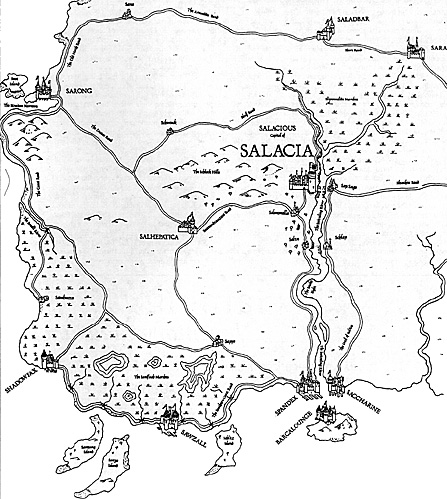This shows two sections of a much larger map drafted for use in an IWG (International Wargame) where each player was the king of a country. The country shown in Salacia, and for ease of play all names in one country started with the same letter. Bluff road and Dusty road are two exceptions, put in only because in making this copy the artist's memory failed him. Use of a Vector map can be quite exciting and successful depending on your other control procedures and what type of group you are gaming with. In the game the artist played in, movement was done by players sending in "overlays" of tracing paper showing the movement and number of forces. The umpire then compared overlays to see if there was any contact.
This kind of game works if you are using these overlays for only general movement instructions and intentions, or for very specific and detailed ones. Times of departure and arrival (in moves) were noted. Of course if you put a more exact construction on them, the possibilities of arguments will arise, also minor distances become very important and persnickety players may quibble over any "smoothing" you do. It will also work if you dispense with overlays and instead substitute a table of march rates. For example, the time to march from Sarong to Sano could be noted and players could then simply chose their routes by naming rooads. Like "Salacious- Bluff Road, Schmuck Dustee Road, Coast Road, Sarong. "Off the road" movement is very problematic in this system, but can be done, again depending on how much dispensation the players are willing to give the umpire.
As a planning and Audio visual tool, vector movement maps are unsurpassed because they give endless opportunities for "what if's or individual initiative. For example Assume that the country of Burmashave (which owns the port of Barcalounge) has made a surprise attack and taken Sawzall. The Slacions are hard pressed to retake it because it is along the coast road with it's numerous easily defensible bridges and they don't want to do a "New Orleans" over and over again. The Salacious player might well try and start an army from Sappi and build a road to the large shallow lake just to the south-east of town. Then, bring up boats, float an army across the lake to the stream that flows to the sea, and move down to besiege Sawzall direct. Depending on how he does and how resourceful he is, he may be leading a fiasco or on the fast-track to greatness.
Perhaps the most alluring thing about Vector maps is that of all the types available to gamers, they LOOK the most like the real thing, or the large scale maps real generals would use. Rules would have to be worked out to figure out how much space on the map equals a battlefield on the table top. In this game a table top battlefield of 4 by 8 measured 1/4" by 1/2".
Further, you must decide if the terrain shown on the map is the ONLY terrain allowed, or simply the GENERAL terrain situation. If the latter, some means of generating and apportioning terrain would need to be arranged. Where games do not have battlefield resolution, and you are fighting simply the campaign, this is not a problem. In games where you are, some form of terrain generation is recommended as players will soon tire of fighting battles on a flat field with a road running down the center.
A Vector Map

More Campaigns or Campains?
-
Campaigns or Campains: Introduction
Campaigns or Campains: The Proctor System
Campaigns or Campains: Vector Movement System
Campaigns or Campains: Scourge of God Outline
Campaigns or Campains: Control Method Comparison Table
Back to Table of Contents -- Courier #78
To Courier List of Issues
To MagWeb Master Magazine List
© Copyright 2000 by The Courier Publishing Company.
This article appears in MagWeb (Magazine Web) on the Internet World Wide Web.
Other military history articles and gaming articles are available at http://www.magweb.com